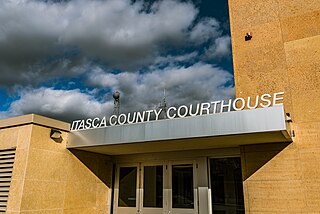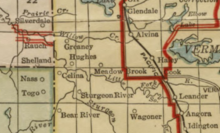
Duluth is a port city in the U.S. state of Minnesota and the county seat of St. Louis County. Located on Lake Superior in Minnesota's Arrowhead Region, the city is a hub for cargo shipping. Commodities shipped from the Port of Duluth include coal, iron ore, grain, limestone, cement, salt, wood pulp, steel coil, and wind turbine components. Duluth is south of the Iron Range and the Boundary Waters Canoe Area Wilderness.

St. Louis County is a county located in the Arrowhead Region of the U.S. state of Minnesota. As of the 2020 census, the population was 200,231. Its county seat is Duluth. It is the largest county in Minnesota by land area, and the largest in the United States by total area east of the Mississippi River. St. Louis County is included in the Duluth, MN–Superior, WI Metropolitan Statistical Area.

Hennepin County is a county in the U.S. state of Minnesota. Its county seat is Minneapolis, the state's most populous city. The county is named in honor of the 17th-century explorer Father Louis Hennepin. The county extends from Minneapolis to the suburbs and outlying cities in the western part of the county. The county's natural areas are covered with extensive woods, hills, and lakes.

Chisago County is a county in the east-central part of the U.S. state of Minnesota. The county covers an area of 442 square miles and, as of the 2020 Census, had a population of 56,621 people. It is part of the Minneapolis-St. Paul-Bloomington Metropolitan Statistical Area.

Grand Rapids is a city in Itasca County, Minnesota, United States, and it is the county seat. The population was 11,126 at the 2020 census. The city is named for the 3.5-mile (5.6 km) long rapids in the Mississippi River which was the uppermost limit of practical steamboat travel during the late 19th century. Today the rapids are hidden below the dam of UPM Paper Company.

Fergus Falls is a city in and the county seat of Otter Tail County, Minnesota, United States. The population was 14,119 at the 2020 census.
Linden Grove Township is a township in Saint Louis County, Minnesota, United States. The population was 145 at the 2010 census.

The Duluth MN–WI Metropolitan Area, commonly called the Twin Ports, is a small metropolitan area centered around the cities of Duluth, Minnesota and Superior, Wisconsin. The Twin Ports are located at the western part of Lake Superior and together are considered one of the larger cargo ports in the United States. The Twin Ports are close to many natural attractions such as the North Shore, the Apostle Islands, and the Superior National Forest.

U.S. Route 53, or U.S. Highway 53 (U.S. 53), is a north–south U.S. highway that runs for 404 miles (650 km) from La Crosse, Wisconsin to International Falls, Minnesota. It is the primary north–south route in northwestern Wisconsin, serving as a vital link between I-94 at Eau Claire, Wisconsin and the Twin Ports of Superior, Wisconsin, and Duluth, Minnesota. The entire route from Eau Claire to the city limits of Superior is a four lane divided highway. The highway's northern terminus is at the Fort Frances–International Falls International Bridge in International Falls, Minnesota, at the Canada–US border. Its southern terminus is in La Crosse, Wisconsin, at U.S. Highway 14.

Minnesota State Highway 61 is a 150.321-mile-long (241.918 km) highway in northeast Minnesota, which runs from a junction with Interstate 35 (I-35) in Duluth at 26th Avenue East, and continues northeast to its northern terminus at the Canadian border near Grand Portage, connecting to Ontario Highway 61 at the Pigeon River Bridge. The route is a scenic highway, following the North Shore of Lake Superior, and is part of the Lake Superior Circle Tour designation that runs through Minnesota, Ontario, Michigan, and Wisconsin.

Minnesota State Highway 23 (MN 23) is a state highway that stretches from southwestern to northeastern Minnesota. At 343.723 miles (553.169 km) in length, it is the second longest state route in Minnesota, after MN 1.

Minnesota State Highway 210 (MN 210) is a state highway in west-central, central, and northeast Minnesota, which runs from North Dakota Highway 210 (ND 210) at the North Dakota state line, and continues east to its eastern terminus at its intersection with MN 23 in Duluth near the Saint Louis River.

Minnesota State Highway 39 (MN 39) is a short 1.080-mile-long (1.738 km) highway in northeast Minnesota, which runs from its intersection with State Highway 23 in Duluth and continues east to its eastern terminus at the Wisconsin state line, where it becomes Wisconsin Highway 105 upon entering the village of Oliver, Wisconsin.
Greaney is an unincorporated community in Saint Louis County, Minnesota, United States. Greaney is located within ZIP code 55771, based in Orr.
Bengal was an unincorporated community on the boundary of Itasca County and Saint Louis County, Minnesota, United States, located about three hours north of Minneapolis. Bengal was also previously known as Powers.
Bear River is an unincorporated community in Itasca and Saint Louis counties in the U.S. state of Minnesota.

The Norwegian Lutheran Church in the United States is a general term to describe the Lutheran church tradition developed within the United States by immigrants from Norway.

U.S. Highway 2 (US 2) is a United States Numbered Highway in northwest and northeast Minnesota, which runs from the Red River at East Grand Forks and continues east to Duluth, where the route crosses the Richard I. Bong Memorial Bridge over the Saint Louis Bay. The route connects the cities of East Grand Forks, Bemidji, Grand Rapids, and Duluth.
John Nathan Kildahl was an American Lutheran church minister, author and educator.
Rauch is an unincorporated community in Koochiching County, Minnesota, United States.
















